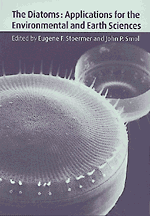Book contents
- Frontmatter
- Contents
- Contributors
- Preface
- Part I Introduction
- Part II Diatoms as indicators of environmental change in flowing waters and lakes
- Part III Diatoms as indicators in extreme environments
- Part IV Diatoms as indicators in marine and estuarine environments
- 13 Diatoms as indicators of coastal paleoenvironments and relative sea-level change
- 14 Diatoms and environmental change in brackish waters
- 15 Applied diatom studies in estuaries and shallow coastal environments
- 16 Estuarine paleoenvironmental reconstructions using diatoms
- 17 Diatoms and marine paleoceanography
- Part V Other applications
- Part VI Conclusions
- Glossary, and acronyms
- Index
15 - Applied diatom studies in estuaries and shallow coastal environments
Published online by Cambridge University Press: 16 January 2010
- Frontmatter
- Contents
- Contributors
- Preface
- Part I Introduction
- Part II Diatoms as indicators of environmental change in flowing waters and lakes
- Part III Diatoms as indicators in extreme environments
- Part IV Diatoms as indicators in marine and estuarine environments
- 13 Diatoms as indicators of coastal paleoenvironments and relative sea-level change
- 14 Diatoms and environmental change in brackish waters
- 15 Applied diatom studies in estuaries and shallow coastal environments
- 16 Estuarine paleoenvironmental reconstructions using diatoms
- 17 Diatoms and marine paleoceanography
- Part V Other applications
- Part VI Conclusions
- Glossary, and acronyms
- Index
Summary
Introduction
Diatoms are an important and often dominant component of the benthic microalgal assemblage in estuarine and shallow coastal environments. This chapter will be concerned mainly with the motile diatom assemblages of intertidal sediments in these environments and secondarily with diatom assemblages epiphytic on submerged aquatic vegetation. Admiraal (1984) provided an excellent summary of the ecology of estuarine sediment-inhabiting diatoms. A variety of topics was covered, including distribution, effects of physicochemical factors, population growth, primary production, and interactions with herbivores. The focus of the present review will be considerably narrower as only those applied studies which have utilized structural (e.g., species diversity) and/or functional (e.g., primary production rates) attributes of benthic diatom assemblages will be considered. By applied is meant studies that treat benthic diatom assemblages as tools to address concerns about larger ecosystem problems such as cultural eutrophication of estuarine and shallow coastal environments. The three diatom-related research topics that will be reviewed in this chapter include eutrophication, sediment stability, and resuspension. These topics are important because of threats posed to estuarine and shallow coastal systems by increasing nutrient levels and reduced light transmission in the water column; both may significantly impact the role of algae and other primary producers in trophic dynamics and consequently affect ecosystem health. Relevant studies conducted in the Baltic Sea will not be included as they will be part of the chapter on applied studies of diatoms in brackish waters by Snoeijs (this volume).
- Type
- Chapter
- Information
- The DiatomsApplications for the Environmental and Earth Sciences, pp. 334 - 351Publisher: Cambridge University PressPrint publication year: 1999
- 19
- Cited by

